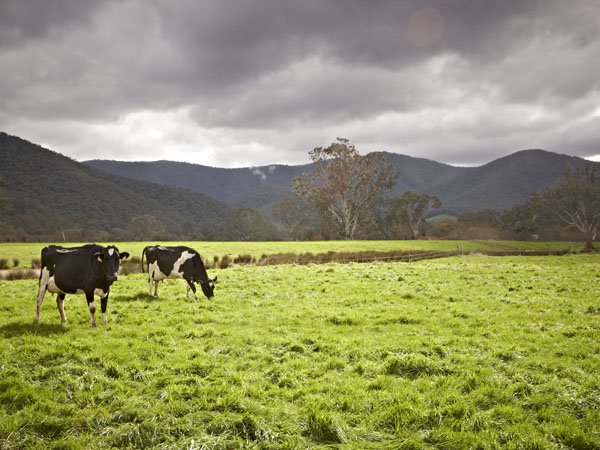Dairy’s climate changing future
By Dairy Australia
Twenty years from now, dairy farming will look and feel much different.
By 2040, farmers will have to deal with warmer temperatures and more extreme weather events, while more variable rainfall will see seasons shift and feeding strategies altered. Summers will extend well beyond the usual summer period and dry spells will last longer.
The forecast change has prompted a team of researchers at the University of Melbourne’s Primary Industries Climate Challenges Centre and Dairy Australia to apply climate modelling to specific farms to analyse how key Australian dairy regions might perform in the future.
Using three farms; in Victoria’s Gippsland region, South Australia’s Fleurieu Peninsula, and north-west Tasmania, researchers applied climate, biophysical and economic models to develop projections for each farm system.

Farmers have reported they are increasing the amount of shade and shelter available for stock during extreme weather events. Photo courtesy Dairy Australia.
Researchers Dr Brendan Cullen and Dr Margaret Ayre, from the University of Melbourne, worked alongside scientists from the Tasmanian Institute of Agriculture, economists, farm consultants, and farmers from the three regions to develop a comprehensive picture of how each farm might perform.
“The modelling allowed us to predict some critical indicators of farm performance, covering everything from future climatic conditions, to pasture growth, milk production, and farm profits,” Dr Cullen says.
“Most significantly, we’ll see a shift in the pasture growing season. Growth rates will be higher in winter and early spring but lower for the rest of the year. Overall, this means less pasture production, and that will create a real feed challenge.”
Dr Cullen and the team looked at a range of different business development options to explore how farmers might adapt their farms to manage challenges such as this. The options broadly represented a trajectory from ‘less intensified’ to ‘more intensified’ dairy production.
One critical finding was that climate change had a negative effect on the profitability of each farm regardless of the development option, largely because higher temperatures and longer dry spells reduced pasture utilisation.
Across the three case study farms, the research identified a loss of operating profit of 10-30 percent due to climate change in 2040 if farmers did not adapt to the warmer and drier climates.
For project leader Gillian Hayman, a dairy extension consultant at Dairy Australia and dairy farmer from southern Gippsland, the project’s findings have confirmed the challenges she sees ahead for the dairy industry.
“Many of the farmers involved in the research had observed and managed through variable climatic seasons in the past. Floods, bush fires, heat waves, extremely wet winters and extended dry periods have all been a part of the last 15 years for farmers,” she says.
“Dairy farmers already need to be at the top of their game, adapt to conditions and continually review their game plan from season to season. Climate change is yet another pressure on farmers along with milk price variability.”
“One area that we’re concerned farmers aren’t prepared for is the more extreme changes from climate averages. Recent heat waves have been a challenge for many,” Gillian said.
Farmers reported they were increasing the amount of shade and shelter available for stock during extreme weather events, increasing farm water storage, and carrying larger fodder reserves from year to year.
The study’s predictions on what future climates will mean for pasture production and farm profitability highlight the critical need for the industry to foster continued and more widespread adaptation in a warming and drying climate.
Read the full study here: http://ow.ly/GjGp30b6DgZ.
Adapted from a University of Melbourne article originally published in August 2016. This project was funded by the Australian Government and Dairy Australia. The research was undertaken by the Tasmanian Institute of Agriculture, the University of Melbourne and D-Arm Consulting.



